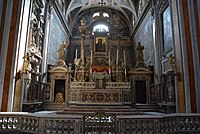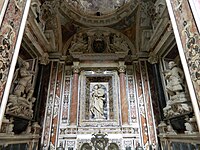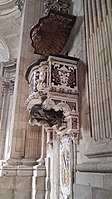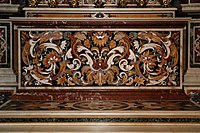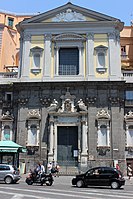Cosimo Fanzago
Cosimo Fanzago (baptized October 13, 1591 in Clusone ; died February 13, 1678 in Naples ) was an Italian architect , sculptor, and decorator . He is considered the most important exponent of the Baroque in Naples, especially in the field of interior decoration, where he created his own flowery style of polychrome marble incrustations .
biography

Fanzago was born in Clusone near Bergamo to Ascenzio Fanzago and Lucia Bonicelli. In his family there had been an artistic tradition of sculptors for several generations, especially in bronze casting , known are his ancestors Alessio, Giannantonio, Marino, and above all the engineer and mathematician Pietro Fanzago.
In a document from 1612 Cosimo himself reports that he had come to Naples about four years earlier, in 1608, “... to learn the art of marble sculpture, and that he lives in the house of Pompeo Fanzago, my paternal uncle ... ". The said document, dated August 12, 1612, is an employment contract with Angelo Landi , a sculptor from Florence. Only a few weeks later, on September 23 of the same year, Cosimo Fanzago married Landi's daughter, Felicia. The marriage produced four children: Caterina Vittoria, Ascenzio, Ursula and Carlo; his wife died in 1645.
His first important work was the grave monument of Mario Carafa, a relative of Cardinal Carafa. His architectural debut was the plan for the Church of San Giuseppe dei Vecchi in San Potito (completed in 1669).
Fanzago received orders and a. by the Jesuits , for whom he worked on San Francesco Saverio from 1618 , and played a decisive role in the decoration of Gesù Nuovo over the decades . The Certosa di San Martino belongs to the absolute main and masterpieces of Fanzago , where he was involved from 1623 to 1656 with essential work on the cloister , inside the church and on the facade, as well as in the apartment of the prior ; At the beginning he worked with Gian Giacomo Conforto (until 1627), from 1630 to 1656 he directed the work at the Certosa. According to his plans, the bronze portal to the Cappella di S. Gennaro in the cathedral of Naples was realized (1630–1668 by G. Monte), he himself created a bronze statue of St. Teresa for the same chapel.
At the end of the 1620s Fanzago had various projects outside of Naples: he worked in the Abbey of Montecassino between 1626 and 1631 , and is in Venice from 1629 to 1630 , where he created the main altar for San Nicola al Lido ; he was also involved in the construction of several churches in Bergamo.
Fanzago's success was already so great in the 1630s that in 1636, on behalf of Viceroy Manuel de Zúñiga y Fonseca, conte di Monterrey, he supplied the plans for the gate grille and pulpit for the Augustinian church in Salamanca (Spain), which was built according to plans by Picchiatti from 1633 . The next viceroy Ramiro Nuñez de Guzmán, duca de Medina, asked him in 1640 to carry out the Porta Medina in Naples.
In 1647 Fanzago was involved in the events surrounding the famous Masaniello revolt . On July 13, 1647, the rights granted to the people were established and the Spanish viceroy Rodrigo Ponce de León, Duke of Arcos , was sworn in, and it was decided to present chapters and privileges publicly in the marketplace in an epitaph. Cosimo Fanzago received the order for this so-called Epitaffio del Mercato (on the Piazza del Mercato) by the Duca d'Arcos at Masaniello's request. However, the work remained unfinished and was demolished in 1800. Fanzago was accused of collaborating with Spanish foreign rule and he was forced to flee Naples.
In the following years until 1655 he lived mostly in Rome , where he a. a. Received commissions on the occasion of the jubilee year 1650 in St. Peter's Basilica , also in San Lorenzo in Lucina , Santo Spirito dei Napoletani (the facade, destroyed in 1853), in Sant'Agostino (for which he later created a second holy water font in 1660 ), Sant'Isidoro ( cappella di S. Antonio ), Santa Maria in Via Lata , and for the refectory of the Church of SS. Trinità dei Pellegrini (portal). Virgilio Spada , the main patron of Borromini , also let Fanzago decorate his family chapel in San Girolamo della Carità (1655).

Back in Naples, Fanzago worked partly with Francesco Antonio Picchiatti , a. a. on the facade to Pio Monte della Misericordia (1666) and in the restoration of the church and convent of Santa Maria dei Miracoli (1675, with D. Tango and D. Lazzari).
In the course of his life, Fanzago shaped the cityscape of Naples not only through numerous and important works for churches and chapels, but also through various fountains: the Fontana dello Spirito Santo (1618–1620, lost); the Fontana del Nettuno (or Medina) (1634–1639 with the sons Ascenzio and Carlo); and the Fontana del Sebeto (1635–1637, with S. Rapi and Carlo Fanzago); also some pillars of plague: the Guglia di San Gennaro (1637–1660) and the Guglia di San Domenico (1665–1666; the latter together with Picchiatti). In the field of secular architecture, he worked from 1637 on various projects in Via Toledo, sometimes connected with property investments (Palazzo Zevallos Stigliano, 1639–1663; Palazzo Maddaloni). He also worked on the Palazzo Spinelli, from 1642–1643 on the Palazzo of Donn'Anna Carafa , wife of the Viceroy of the Duke of Medina, in Posilippo , and on the loggia of the Palazzo Maddaloni (after 1652, perhaps 1664).
Fanzago also designed the plans for Santa Teresa a Chiaia , and for numerous churches and other projects in southern Italy: in Avellino and for the Certosa of Padula ( Campania ); in Barletta ( Apulia ); in Soriano Calabro , Badolato and in the Certosa of S. Stefano del Bosco (in Calabria ); as well as in Pescocostanzo ( Abruzzo ). His last major church was Santa Maria Maggiore della Pietrasanta in Naples (1653 to 1675).
Cosimo Fanzago died in 1678 at the age of 87 and was buried on February 13 in the church of S. Maria d'Ognibene. Lorenzo Vaccaro was one of his students .
Work and meaning

When Fanzago came to Naples, the sculpting scene was mainly dominated by Tuscan artists, such as Landi, Felice de Felice , Vitale Finelli , or Pietro Bernini (the father of Gian Lorenzo ), who, however, had already moved to Rome in 1607. These artists were still characterized by a "classical mannerism ", but already with the beginning of a naturalistic baroque.
On this basis, Fanzago invented his own lush and virtuoso style, particularly in the area of marble incrustation , which is characterized by extreme elegance and naturalistic shapes, a combination of floral and geometric motifs, and a virtuoso handling of chromatic color gradations. His originality and the novelty of his “architettura / decorazione” or his “semi-decorative” art ( arte semidecorativa ) was widely recognized by art critics of the 20th century. All art historians also agree that Fanzago's inventions in San Martino and elsewhere gave rise to a style of its own, "which developed continuously in the seventeenth century and was not only typical of Naples, but uniform and specific for all of southern Italy".
An assessment of Fanzago's architectural work is generally more difficult because there are no sacred or civil buildings that were entirely his own: he was often involved in projects that had already been started by others, and his own designs were usually made by others To the end without more detailed plans being preserved. In principle, Fanzago seems to have had a preference for the shape of the Greek cross in the churches he designed . B. at the Chiesa dell'Ascensione (1626-1645) and also - with a slight emphasis on the longitudinal axis - at Santa Maria dei Monti (begun 1628), in San Giuseppe dei Vecchi in San Potito (from 1634), and in Santa Maria Maggiore della Pietrasanta (started before 1634).
Major works (selection):
- Numerous works in the Certosa di San Martino (facade, nave, cloister), Naples
- The two large chapels of the transept and other works in Gesù Nuovo , as well as the entrance portal of the Jesuit college in Naples
- The baroque decoration of the Montecassino Abbey (destroyed in World War II, later partially reconstructed)
- Different churches in Naples: San Ferdinando , Santa Teresa a Chiaia , Chiesa dell'Ascensione a Chiaia , Santa Maria Maggiore alla Pietrasanta , the Basilica San Giorgio Maggiore .
- Facades of the churches of San Giuseppe a Pontecorvo and Santa Maria degli Angeli alle Croci in Naples.
- The Santuario di Santa Maria dei Miracoli in Andria
- The bronze grille of the Cappella del Tesoro di San Gennaro in the Cathedral of Naples .
- Apse and main altar and other work in Santa Maria del Carmine Maggiore , Naples.
- The main altars in the churches of Santa Maria di Costantinopoli , Santa Maria la Nova , San Domenico Maggiore , San Pietro a Majella , and Ss. Severino e Sossio , Naples
- Altar of the Holy of Holies in Palermo Cathedral
- Main altar of the Basilica Concattedrale di Sant'Agata in Gallipoli .
- Various chapels in Neapolitan churches: the Cappella Firrao in San Paolo Maggiore , the Cappella di Santa Teresa in Santa Teresa agli Studi, the Cappella De Caro Cacace and the great chapel of St. Anthony in San Lorenzo Maggiore (approx. 1640-1650), which Chapel of St. Teresa d'Avila in the Church of Santa Teresa degli Scalzi (1640).
- the Palazzo Zevallos and the Palazzo Carafa di Maddaloni in Naples
- The so-called Palazzo di Donn'Anna in Posillipo .
- Restoration of the Complesso di San Gaudioso
- The Guglia di San Gennaro , Naples
- the Fontana del Sebeto , Naples
- Large cloister and cemetery in the Certosa di Padula
- The plan for the Basilica Santa Maria Egiziaca in Pizzofalcone is also attributed to Fanzago.
Picture gallery
Entrance portal of the Cappella di San Gennaro in the Cathedral of Naples
The Cappella di Sant'Ugo in the Certosa di San Martino , Naples
Busts of Nicolò Albergati (left) and Saint Martin (right) by Cosimo Fanzago and Domenico Antonio Vaccaro , cloister of the Certosa di San Martino, Naples
Main altar of the Santa Maria la Nova church in Naples
Cappella Firrao in San Paolo Maggiore
Pulpit designed by Fanzago in the Iglesia de la Purísima, Salamanca (Spain)
The marble decor of the Montecassino Abbey , which was destroyed in World War II and later reconstructed , was designed by Fanzago.
Facade of the Chiesa di Santa Teresa degli Scalzi , Naples
literature
- Paola D'Agostino: Cosimo Fanzago scultore , Paparo Edizioni, 2011, Napoli (Italian)
- Ciro D'Arpa: "La committenza dell'arcivescovo Martino Leon y Cardenas per la Cattedrale di Palermo (1650–1655): un intervento inedito dell'architetto Cosimo Fanzago", in: Palladio, n.21 , 1998, p. 35– 46 (Italian)
- Gaetana Cantone: Napoli Barocca , Napoli, Laterza, 2002 (Italian)
- Giuseppe Ceci: "Il primo passo di Cosimo Fanzago", in: Napoli Nobilissima , SN, II, 1921, pp. 142–143 (Italian)
- G. Dolcetti: “Fanzago e Cartolari”, in: Il libro d'argento delle famiglie venete , Vol. IV, Bologna, Forni Editore, 1922–1928, pp. 34–39. (Italian)
- Aliprando Fanzago degli Aliprandi: "I conti di Bergamo ed i discendenti Aliprandi, Rosmini, Fanzago e Fanzago-Cartolari", pp. 120–127 (Italian)
- Riccardo Lattuada: "Cosimo Fanzago ispirato e rivisitato", July 6, 2017, in: About Art online , last seen on September 11, 2018. (Italian)
- Aurora Spinosa: FANZAGO, Cosimo. In: Fiorella Bartoccini (ed.): Dizionario Biografico degli Italiani (DBI). Volume 44: Fabron-Farina. Istituto della Enciclopedia Italiana, Rome 1994.
- Aurora Spinosa (Ed.): Protagonisti nella storia di Napoli. Grandi Napoletani. Cosimo Fanzago , Napoli, Elio de Rosa editore, 1996 (Italian)
Web links
- Web Gallery of Art
- Jusepe de Ribera, 1591–1652 , a full text exhibition catalog from The Metropolitan Museum of Art, which includes material on Cosimo Fanzago (see index)
Individual evidence
- ↑ a b c d e f g h i j k l m n o p q r s t u v Aurora Spinosa: "FANZAGO (Fonsaga, Fansago, Foriseca), Cosimo (Cosmo)", in: Dizionario Biografico degli Italiani, Volume 44 , 1994, online on Treccani
- ↑ “… per imparare l'arte di scultura di marmo et me ne venni a stare alla casa di Pompeo Fanzago mio zio da parte di padre…”. Quoted from: Ceci, 1921, p. 143. Here from: Aurora Spinosa: "FANZAGO (Fonsaga, Fansago, Foriseca), Cosimo (Cosmo)", in: Dizionario Biografico degli Italiani, Volume 44 , 1994, online on Treccani
- ^ A b Riccardo Lattuada: "Cosimo Fanzago ispirato e rivisitato", July 6, 2017, in: About Art online
- ^ “Tutti gli storici concordano sul fatto che la koinè generata dalle invenzioni di Fanzago a San Martino e altrove, pur evolvendosi di continuo nel corso del Seicento, fu unitaria e specifica di tutto il Meridione continentale.” See: Riccardo Lattuada: “Cosimo Fanzago ispirato e rivisitato “, July 6, 2017, in: About Art online
| personal data | |
|---|---|
| SURNAME | Fanzago, Cosimo |
| BRIEF DESCRIPTION | Italian sculptor, decorator and architect |
| DATE OF BIRTH | baptized October 13, 1591 |
| PLACE OF BIRTH | Clusone |
| DATE OF DEATH | February 13, 1678 |
| Place of death | Naples |






